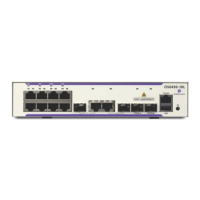Configuring Server Load Balancing Configuring SLB Probes
OmniSwitch AOS Release 7 Network Configuration Guide March 2011 page 19-21
For example, to set the URL for an HTTP SLB probe called “server_probe1” to “pub/index.html”, enter:
-> ip slb probe server_probe1 http url pub/index.html
Modifying the Probe Status
To modify this value, use the ip slb probe status command by entering ip slb probe followed by the
user-configured probe name, either http or https, status, and the user-specified expected status.
For example, to set the expected status for an HTTP SLB probe called “server_probe1” to 404, enter:
-> ip slb probe server_probe1 http status 404
Configuring a Probe Send
To configure an ASCII string sent to a server to invoke a response from it and to verify its health use the
ip slb probe send command by entering ip slb probe followed by the user-configured probe name, the
valid probe type (udp or tcp), send, and the user-specified ASCII string.
For example, to set the TCP/UDP port for an TCP SLB probe called “server_probe1” to “test”, enter:
-> ip slb probe server_probe1 tcp send test
Configuring a Probe Expect
To configure an ASCII string used to compare a response from a server to verify the health of the server
use the ip slb probe expect command by entering ip slb probe followed by the user-configured probe
name, the valid probe type (http, https, udp, or tcp), expect, and the user-specified ASCII string.
For example, to set the TCP/UDP port for an HTTP SLB probe called “server_probe1” to “test”, enter:
-> ip slb probe server_probe1 http expect test

